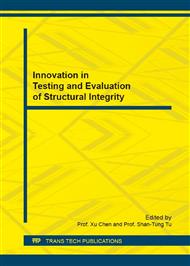p.163
p.168
p.173
p.178
p.187
p.192
p.197
p.204
p.209
Multiaxial Ratcheting Behavior of M5 Zirconium Alloys Tubes in Different Loading History
Abstract:
In this study, a series of multiaxial ratcheting tests under combined cyclic axial and inner pressure were conducted on M5 zirconium alloys tubes used as nuclear fuel cladding in Pressurized Water Reactors (PWRs) for the purpose to investigate the multiaxial ratcheting behavior of M5 and the factors of loading history may influence it. The experiment was stress-controlled and designed in a special loading path that all tubes in actually were under axial symmetrical cyclic load and constant inner pressure. A set of new patent multiaxial clamp was designed and applied to make sure the tubes can withstand inner pressure and axial load at the same time. A dynamic closed-loop multiaxial testing controller was used to manipulate two actuators simutaneously. Biaxial strain gauges were adopted to detect the signals of axial and hoop strain during the tests. The experimental results show that axial ratcheting strain decreases obviously within the original cycles reaching to a stop in certain cycles, the axial ratcheting increases with the cycles going. Loading history has obvious influence on the ratcheting behavior in axial direction. Higher stress amplitude level after loading history with lower stress amplitude level leads to an abnormal ratcheting behavior. The axial ratcheting shows a high sensitive to the complex loading history, especially when the stress amplitude is high. The hoop ratcheting strain accumulates continuously with the cycles going. Loading history has no obvious influence on hoop ratcheting strain and its ratcheting when the stress amplitude is low. The ratcheting strain and its rate shows more sensitive to the loading history when the stress amplitude increases to a certain value.
Info:
Periodical:
Pages:
187-191
Citation:
Online since:
September 2016
Price:
Сopyright:
© 2017 Trans Tech Publications Ltd. All Rights Reserved
Share:
Citation:


